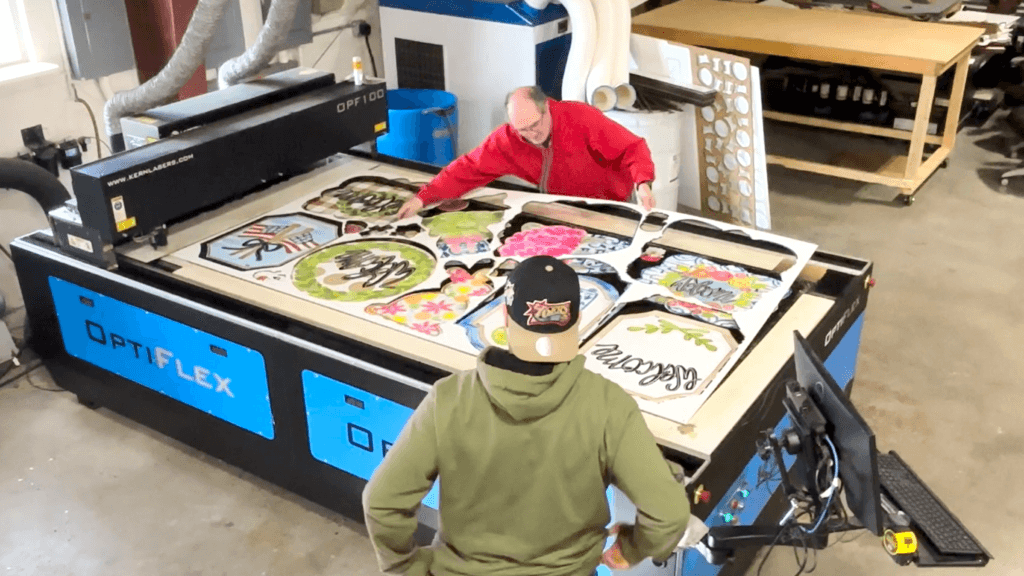In the many years Kern has been in the laser industry one thing has always been true: Customers want more power to engrave quicker and cut thicker material faster. In 2013 we developed our first laser with a rated power of 150 watts and released it to the market. Soon after, customers were asking for more power. In 2016 we released a 400-watt laser that quickly became a best seller. Again we listened to our customers requesting more power and are now releasing a 650-watt laser. This power level fills a gap the United States CO2 laser market has been missing.
Features
Size and Weight
The KT650 is conveniently offered in the same overall footprint as our KT250 and KT400 models. The laser beam output position, mounting points, and overall package size match up exactly to our 250 and 400-watt laser models. No need for current customers to redesign how to mount the laser into their existing machine architect.
A redesign of the laser resonator cavity allowed us to maximize power while adding less than 10 lbs. to the overall weight of the KT650 when compared with the KT400. Needless to say this laser packs a punch for its size and weight.
The KT650 can go up against any similar CO2 laser on the market as it offers the most power, pound for pound, in a compact, convenient package.
Patent Pending Laser Resonator Technology
The new patent-pending laser resonator design1 produces a high-quality top-hat-like raw mode. Through external optics, we shape this beam into a near-diffraction-limited Gaussian beam. Starting with such a high-quality raw mode allows for less power to be lost in the external beam delivery. This allows us to produce the common Gaussian-like CO2 laser beam in a highly efficient manner with minimal spatial filtering or beam apodizing required. The result is a high-quality, round beam with low divergence from a very efficient laser source that has a high wall-plug efficiency compared to similar CO2 lasers.
Rise and Fall Time
The rise and fall time may not be the first laser specifications you look at when comparing lasers but it does play a very important role when processing material. The benefits of a fast rise and fall time include easier piercing of material, less heat-affected zone, and a well-defined pulse which is desirable for specific low frequency, pulse applications. The KT650 has a rise and fall time under 40 microseconds making it an ideal laser for anyone looking for improved piercing capabilities and a high-quality processed edge. Customers cutting metal will also notice parts just processed on the laser system feeling cooler to the touch as they collect their finished products due to the limited heat affected zone.
Materials and Applications
A CO2 laser at the 650 power level is extremely versatile in the various types of material that it can process. The laser is powerful enough to cut through ¼” steel while it is delicate enough to kiss-cut stickers. The pulse energy, pulse width placement, and stability are well-controlled enough to provide the same high-quality 3D wood engravings our customers have commonly come to know from our samples kit in our lower-powered lasers while significantly increasing the processing speeds.
(Left-side is of stacked metal samples cut by Kern’s 650W Laser, right-side is an example of 3D laser engraving capabilities)
One of the best benefits of using a CO2 laser is that it can process a wide range of materials. You can be processing thick steel in the morning, cutting foam in the afternoon, and finish your day off engraving on wood all with the same laser. Some of the most common materials we see processed with our lasers include acrylic, aluminum, brass, cardboard, copper, foam, glass, leather, PCB material, rubber, steel, plastic, stone, and wood. The material list continues to grow as our customers find new applications for our lasers. If the laser can pierce the material with relative ease then there is a very good chance it can process your material. Applications include cutting, drilling, engraving, kiss-cutting, marking, perforating, and much more.
We plan to add to our material and application lineup by offering wavelengths besides the predominant 10.6 um. Later this year we will be adding a 9.3 um option and possibly 10.2 um soon after that. These other wavelengths provide higher absorption in specific materials which allows for faster processing speeds.
Benefits
Today’s focus of many companies is how to make their processes more efficient and maximize throughput. Customers will be able to do exactly that by adding the new 650-watt laser to their production floor. With an additional 250+ watts of power from our 400-watt laser, the KT650 improves processing speeds by approximately 60% in most materials. This increase in power plus improved rise and fall times will also allow thicker materials to be cut and the possibility of new materials to be processed.
The addition of the 650-watt laser brings our product portfolio range from 100 watts to 650 watts between three different model series sizes. This product release comes with much anticipation from our own employees as well as many of our customers. We will continue our goal to advance CO2 laser technology by manufacturing the highest quality, most dependable, and innovative CO2 lasers on the market while proudly designing and manufacturing lasers in the USA.
[1] Pending patent applications US2021083447A1, EP3793044A1 and CA3089689A1.



